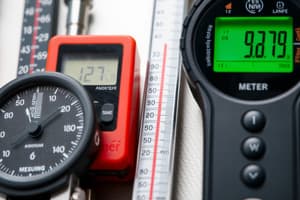Podcast
Questions and Answers
Each inch is divided into halves, quarters, eighths, and ______.
Each inch is divided into halves, quarters, eighths, and ______.
sixteenths
If counting marks leads to 12/16, it needs reduction to ______.
If counting marks leads to 12/16, it needs reduction to ______.
3/4
The highest mark example: ______ is identified by counting marks from halfway.
The highest mark example: ______ is identified by counting marks from halfway.
13/16
The progression of divisions shows that a quarter equals ______ marks.
The progression of divisions shows that a quarter equals ______ marks.
Always check the number of ______ on the tape before measuring.
Always check the number of ______ on the tape before measuring.
Flashcards are hidden until you start studying
Study Notes
Understanding an Inch Measuring Tape
- Focus on basic inch rulers and measuring tapes, excluding machinist rules.
- Typical measuring tape features marks and numbers indicating inches.
Marks on the Measuring Tape
- Most measuring tapes divide each inch into 16 equal parts.
- Counting 8 marks confirms the half-inch mark.
- Some tapes may have 32 marks, so always check the tape before use.
Division of Inches
- Each inch is divided into halves, quarters, eighths, and sixteenths.
- The progression of divisions:
- Half = 2 marks
- Quarter = 4 marks
- Eighth = 8 marks
- Sixteenth = 16 marks
Measuring with a Ruler
- Measure according to the fraction represented by the mark.
- Fractions should always be in simplest form.
Example Measurement
- The mark between 1/2 inch and 1 inch indicates 3/4 inch.
- If counting marks leads to 12/16, it needs reduction to 3/4.
Reducing Fractions
- Simplifying fractions is essential, particularly for tape measures where denominators are consistently 2, 4, 8, or 16.
- To reduce: Keep dividing the numerator by 2 until it’s odd.
Practice Problems
- Practice reducing fractions to understand measurements better.
- Example: 2/8 simplifies to 1/4.
- Another example: 10/16 simplifies to 5/8.
Advanced Measurement
- The highest mark example: 13/16 is identified by counting marks from halfway.
- For measurements exceeding 1 inch: combine whole inches with the fraction (e.g., 1 3/8 inches).
Important Notes
- Always check the number of marks on the tape before measuring.
- Adjust measuring techniques according to the number of divisions.
Understanding an Inch Measuring Tape
- Basic measuring tapes feature marks and numbers indicating inches, allowing for straightforward length measurements.
Marks on the Measuring Tape
- Measuring tapes typically divide each inch into 16 equal parts for precise measurement.
- A quick way to identify the half-inch mark is by counting 8 marks.
- Some measuring tapes may have additional divisions with 32 marks, so it's essential to verify the tape configuration prior to use.
Division of Inches
- Each inch consists of fractions: halves, quarters, eighths, and sixteenths.
- The breakdown of inch divisions:
- Half-inch = 2 marks
- Quarter-inch = 4 marks
- Eighth-inch = 8 marks
- Sixteenth-inch = 16 marks
Measuring with a Ruler
- Accurate measurement requires interpreting the appropriate fraction represented by the marked divisions.
- Fractions should always be represented in their simplest form to avoid confusion.
Example Measurement
- The mark located between 1/2 inch and 1 inch represents the measurement of 3/4 inch.
- If counting leads to an expression like 12/16, it must be simplified to 3/4 for clarity.
Reducing Fractions
- Simplifying fractions is crucial when using measuring tapes as the denominators are frequently 2, 4, 8, or 16.
- To reduce fractions, continually divide the numerator by 2 until reaching an odd number.
Practice Problems
- Engaging in fraction reduction exercises enhances understanding of measurements.
- Example reductions:
- 2/8 simplifies to 1/4.
- 10/16 simplifies to 5/8.
Advanced Measurement
- The highest mark on a standard tape, such as 13/16, can be determined by counting the marks from the halfway point in the inch.
- For measurements that exceed one inch, combine the whole number with the fractional component (e.g., 1 3/8 inches).
Important Notes
- Always check the total number of marks on the measuring tape before taking measurements.
- Adjust measuring strategies based on the number of divisions available on the tape.
Studying That Suits You
Use AI to generate personalized quizzes and flashcards to suit your learning preferences.




